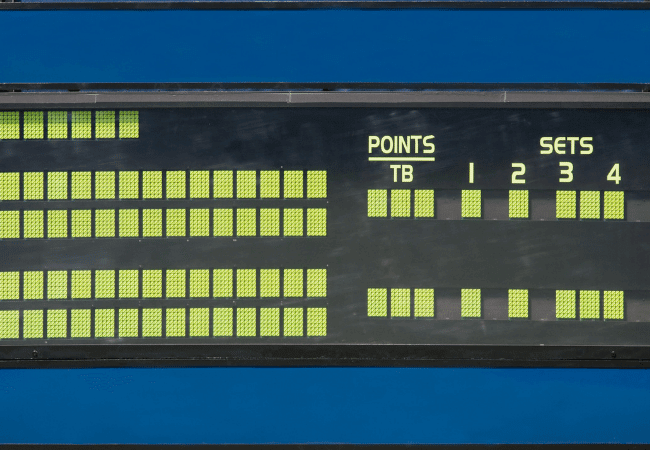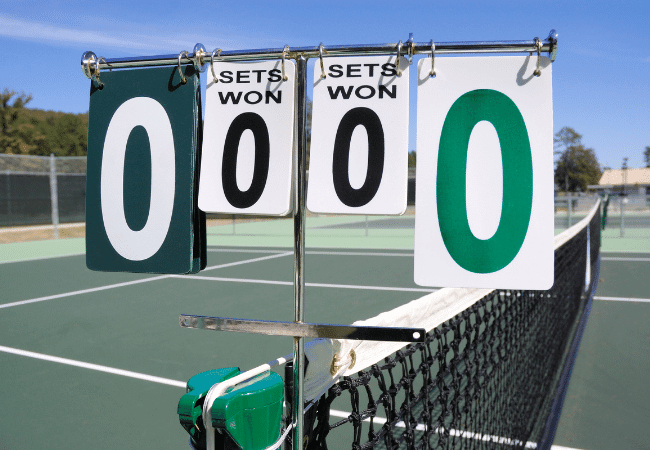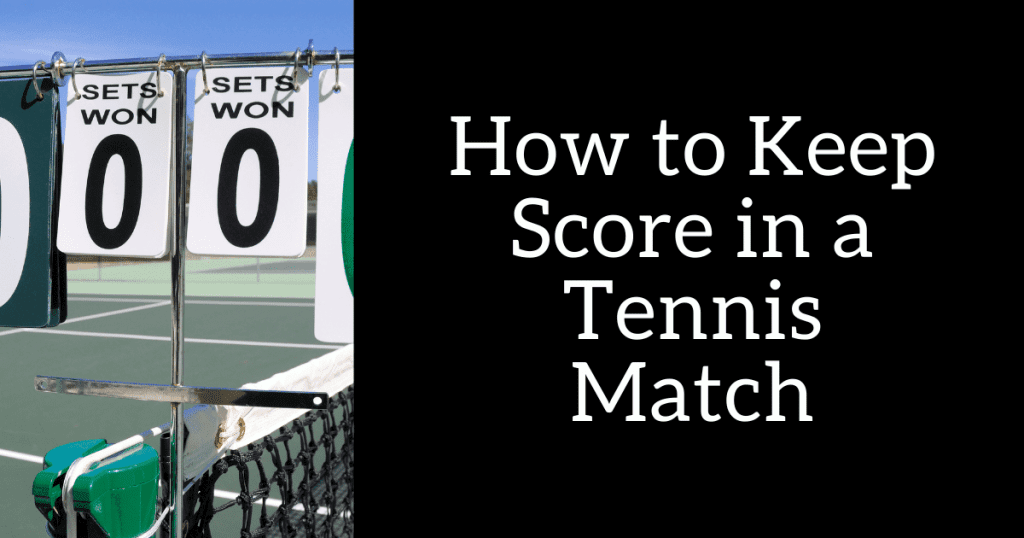In most sports scores are tabulated numerically starting at 1. The tennis scoring system is a slightly different animal. The score of a match does start out at 0-0, but things take a turn once the first point is played.
Read on to learn how to keep score in tennis. You’ll be an expert in no time.
Contents
Game. Set. Match.
Let’s define these terms.
In tennis, the name of the competition itself is a match. From the top down, a match is made up of sets. Sets are made up of games. Games are made up of points.
Let’s work our way down from matches, to sets, to games and points.
Tennis Match Construction: Sets

In most women’s matches, sets are played in a best 2 out of 3 format. The numbers 2 and 3 refer to sets.
Whoever wins 2 sets first wins the match. That could mean that one player wins two sets in a row and the match is over.
Or player A wins set #1 and player B wins set #2 so a third set must be played.
Whichever player wins set #3 wins the match.
In some instances with men’s matches, they play a best 3 out of 5 format.
The numbers 3 and 5 also refer to sets. Whichever player wins 3 sets first wins the match.
There are multiple configurations of how that match could be constructed based on who wins each set.
The fewest number of sets to be played to win the match is 3 and the most would be 5.
Tennis Match Construction: Games
There are some consistencies with tennis scoring. Each set must be won by two games and each game must be won by two points.
The first player to win six games in a set will win the set, but only if they win by two games.
For instance, if you and your opponent have traded games back and forth and arrive at a game score of 5-5, the next person to win a game doesn’t win the set as there isn’t a margin of two games.
One player must win the next two games to win the set or the set will go into a tiebreak (covered below).
The set score in most instances will be one of the following: 6-4, 6-3, 6-2, 6-1, or 6-0.
If you arrive at 5 games all (5-5) and one player wins the next two games, the set is won with a score of 7-5.
Tennis Match Construction: Points
Each game must be won by two points. The first tennis player to win four points in a game will win the game, but only if they win by two points.
For instance, if you and your opponent have traded points and arrive at 40-all/deuce, the next point won won’t win the game.
Let’s get into the nitty gritty of points and the language used to keep score in tennis.
Tennis Game Point Values

Each game in tennis is played to four points but you must win by two points. Instead of using 1, 2, 3, 4/GAME to score, tennis makes things a little more interesting.
When the score is 0-0, it’s Love Love. Yes, 0 in tennis is Love.
This article in Time explains well the history of the term, Love, in tennis.
I could have sworn I saw a movie years ago that explained the reasoning for using the word, Love, was due to the French word for egg, l’oeuf.
Since a zero looks like an egg, that term was used. Nobody is really sure how it came about, but it’s in use today and doesn’t appear to be going anywhere.
(I’m pretty sure I’m wrong about the movie.)
0 = Love
1 point = 15
2 points = 30
3 points = 40
1 point each = 15-all
2 points each = 30-all
3 points each = Deuce (40-all)
Though the verbiage may not be as basic as 1, 2, 3, 4, it’s fairly straightforward until you get to deuce. There are some consistencies in tennis scoring.
Winning by two is one of those consistencies.
...ANNOUNCING THE SCORE
All scores are announced indicating the server’s points first.
As each game switches servers, the announcement of points follows the action of serving and not the player.
If you’re serving and you’ve won two points to one point, the score would be announced, 30-15.
If you were down by two points to one, it would be announced as 15-30.

When you get to deuce, “ad scoring” begins. “Ad” stands for advantage.
There’s “ad in” and “ad out”. In order to win the game with the score at deuce, you must win two points in a row.
“Ad in” refers to the server having an advantage – of a point.
“Ad out” refers to the returner having an advantage – of a point.
In order to win a game that goes to deuce, you must have the ad/advantage and then win the following point.
Let’s walk through a few examples of how a game that gets to deuce can conclude.
–Server wins a point – the score is ad in
–Returner wins a point – the score goes back to deuce
–Returner wins a point – the score is ad out
–Server wins a point – the score goes back to deuce
–The server wins a point – the score is ad in
–Server wins a second point – game ends with the server winning the game
The deuce/ad cycle can go on and on and on. Until one player wins two points in a row, the game will continue.
Explaining Tennis Tiebreakers
It was discussed above that one player must win six games to win each set, but only if they win by two games.
If the score ends up in a tie at 6-6, a tiebreaker begins. The winner of the tiebreaker determines the winner of the set and the score of the set will be 7-6 when it concludes.
A tiebreaker uses more conventional numbering. Games may not use point values of 1, 2, 3, etc., but tennis tiebreakers do.
Like other scoring in tennis, the winner of the tiebreak must win by two points. The goal of the tiebreak is to get to 7 points.
Whoever gets to 7 points first (with a margin of two points) wins the tiebreak and the set.
Now just like with deuce, if the tiebreak score gets to 6-all, the next point won’t win it since you have to win by two points.
Points will continue until one player wins by two points. Scores could be 8-6 or 11-9 or even 25-23.
A tiebreak will continue until one player wins by two points.
For more details, check out this post about tiebreaks.
Final Points...
Scoring in tennis may seem a little odd – and it is – but it’s pretty easy to get the hang of.
Since the score is always announced based on who is serving, you always know where things stand.
After watching a few matches, I’m sure you’ll be a pro and ready for the next time you’re on court.

